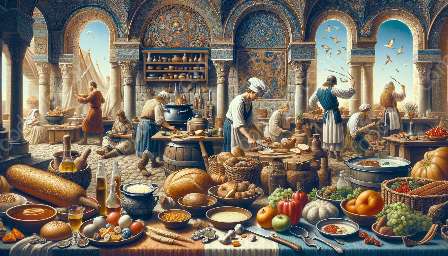The process of domesticating plants and animals for food was a revolutionary development in human history. It allowed early societies to transition from a nomadic existence to settled agricultural communities. This topic cluster will explore the intriguing process of domestication, its impact on ancient and medieval culinary practices, and its enduring influence on food culture and history.
Understanding Domestication
Domestication involves the selective breeding and cultivation of wild plants and animals to make them more suitable for human use. In the case of plants, this often meant developing larger, more nutritious, and easier-to-harvest varieties. For animals, domestication involved taming and breeding wild species to be more docile, productive, and suitable for human needs.
Domestication of Plants
The domestication of plants began around 10,000 years ago in various regions around the world. One of the earliest examples is the cultivation of wheat and barley in the Fertile Crescent, a region in the Middle East. Over time, humans selected and cultivated plants with desirable traits such as larger seeds, increased yield, and resistance to pests and diseases. This led to the development of staple crops that formed the foundation of early agricultural societies.
Domestication of Animals
Similarly, the domestication of animals revolutionized human societies. Dogs were likely the first animals to undergo domestication, serving as hunting companions and guardians. Later, humans domesticated animals like cattle, sheep, and pigs for their meat, milk, and labor. Animals were selectively bred to exhibit traits that made them more useful to humans, such as increased size, lower aggression, and higher productivity.
Ancient and Medieval Culinary Practices
The domestication of plants and animals greatly influenced ancient and medieval culinary practices. With a steady supply of domesticated food sources, ancient societies were able to develop more sophisticated cooking techniques and a wider variety of dishes. In ancient Rome, for example, the diet of the wealthy included a wide range of meats, fruits, and vegetables that were prepared using elaborate cooking methods. Similarly, medieval European cuisine was shaped by the availability of domesticated crops and livestock, leading to the creation of iconic dishes such as stews, roasts, and pies.
Food Culture and History
The impact of domestication on food culture and history is profound and far-reaching. The development of agriculture and the domestication of plants and animals laid the groundwork for the establishment of permanent settlements and the rise of complex societies. This shift also influenced social structures, trade networks, and the development of cuisines that continue to evolve to this day.
The Legacy of Domestication
The legacy of domestication is visible in modern food culture, with many staple foods and culinary traditions tracing their roots back to the earliest domesticated plants and animals. The practice of selective breeding and cultivation continues, leading to the production of diverse and abundant crops and livestock that support the global food supply.
Conclusion
The domestication of plants and animals for food was a pivotal moment in human history, shaping the way we eat, cook, and relate to the natural world. Exploring the ancient and medieval roots of domestication provides valuable insights into our modern food culture and history, highlighting the enduring impact of this transformative process.

